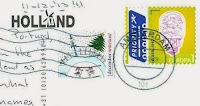Kinderdjik was one of the many places I got to know about because of postcards. I never had much interrest on windmills, that's something we don't have in my region, but after visiting the Kinderdjik once and the Netherlands twice, I'm an huge fan now.
The Mill Network at Kinderdijk-Elshout is a group of buildings in an exceptional human-made landscape in which the centuries-long battle of the Dutch people to drain parts of their territory and protect them against further inundation is dramatically demonstrated through the survival of all the major elements of the complex system that was devised for this purpose.
Construction of hydraulic works for the drainage of land for agriculture and settlement began in the Middle Ages and has continued uninterruptedly to the present day.
© www.postcards-for-postcrossing.com
The property illustrates all the typical features associated with this technology: polders, high and low-lying drainage and transport channels for superfluous polder water, embankments and dikes, 19 drainage mills, 3 pumping stations, 2 discharge sluices and 2 Water Board Assembly Houses. The beautifully preserved mills can be divided into three categories: 8 round brick ground-sailers, 10 thatched octagonal smock mills, and one hollow post mill.
NL-4610496, sent by Janneke.
The installations in the Kinderdijk-Elshout area demonstrate admirably the outstanding contribution made by the people in Netherlands to the technology of handling water.
© Aad Schenk
NL-2234384, sent by Martha.
The landscape is striking in its juxtaposition of its horizontal features, represented by the canals, the dikes, and the fields, with the vertical rhythms of the mill system. There is no drainage network of this kind or of comparable antiquity anywhere else in the Netherlands or in the world. - in: https://whc.unesco.org/en/list/818/



%20-%20C%C3%B3pia.jpg)




No comments:
Post a Comment